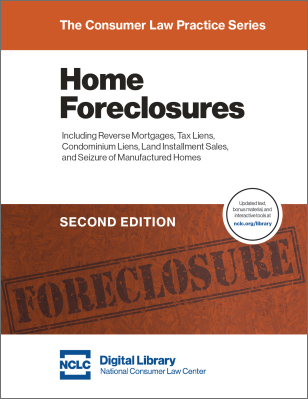In evaluating whether to file a court action for violations of the RESPA Reg. X loss mitigation rule, determine if the servicer evaluated any of the client’s earlier loss mitigation applications. Reg. X, 12 C.F.R. § 1024.41(i) provides that a servicer is "only required to comply with the requirements of this section for a single complete loss mitigation application for a borrower’s mortgage loan account." In other words, the procedural requirements under the loss mitigation rule apply only once per servicer, effectively leaving the borrower with just "one bite at the apple" to bring a RESPA cause of action for loss mitigation rule violations.
The CFPB has proposed modest, but important changes to this poorly conceived "duplicative request" exclusion in a pending rulemaking docket. Until improvements, if any, are finalized and become effective, the expanded discussion and analysis of new court decisions in the just-updated online version of NCLC’s Foreclosure and Mortgage Servicing § 3.2.8.8 will help attorneys with case evaluation on this critical issue.
Six Ways to Avoid the "One Bite" Rule for RESPA Loss Mitigation Applications
The online version of NCLC’s Foreclosure and Mortgage Servicing § 3.2.8.8 also contains a detailed discussion of the factors to consider in reviewing a client’s prior applications and the six arguments you will want to make as to why the exclusion does not apply:
- Prior application was submitted before the rules’ effective date. Several recent decisions have correctly held that the duplicative request exclusion does not apply if the prior servicer evaluation was done on an application submitted before January 10, 2014, the effective date of the loss mitigation rule. Billings v. Seterus, Inc., 2016 WL 1055753 (W.D. Mich. Mar. 17, 2016); Bennett v. Bank of Am., N.A., 126 F. Supp. 3d 871, 884 (E.D. Ky. 2015). Several courts have taken a contrary view, in some cases without even considering the effective date issue. Trionfo v. Bank of Am., N.A., 2015 WL 5165415 (D. Md. Sept. 2, 2015); Bertschy-Gallimore v. U.S. Bank Nat. Ass'n, 2015 WL 3889260, at *7-8 (W.D. Mich. June 24, 2015); Walker v. Driscoll, 2016 WL 617263, at *6 (Md. Ct. Spec. App. Feb. 16, 2016). However, the rule specifies that it applies only if the servicer actually "compl[ied] with the requirements of this section" with respect to the prior application. Thus, a servicer could not possibly have complied with the requirements of § 1024.41 for an application submitted before the rule’s effective date, because there were no comparable requirements under federal law before January 10, 2014.
- Prior application was submitted to a different servicer. An exception to the duplicative request exclusion applies when a loss mitigation application is made to a different servicer on the borrower’s mortgage account, most often when there has been a transfer of servicing. As discussed in the online version of § 3.2.8.3, a transferee servicer is required to comply with the requirements of Reg. X § 1024.41 even if a borrower received an evaluation of a complete loss mitigation application from a transferor servicer.
- Prior application was incomplete, but a loss mitigation option was properly offered. As discussed in the online version of § 3.2.8.2.9, a servicer may offer certain loss mitigation options based on an incomplete application without violating the duty to evaluate the borrower for all loss mitigation options. The CFPB has said that in this situation, any such evaluation and offer is "not subject to the requirements of [Reg. X] § 1024.41 and shall not constitute an evaluation of a single complete loss mitigation application for purposes of § 1024.41(i)." See Section-by-Section Analysis, Reg. X § 1024.41(c), 78 Fed. Reg. 10,829 (Feb. 14, 2013).
- The servicer did not treat the prior application as complete. In order to claim the benefit of the duplicative request exclusion, servicers may be eager to assert that a borrower’s prior application was complete, when in fact it was not. When a servicer repeatedly requests additional information in response to prior applications and does not indicate that those prior applications were complete, these prior applications should not be used by the servicer as a defense in litigation based on the duplicative request exclusion. See, e.g., Thomas v. Wells Fargo Bank, N.A., 2016 WL 1701878, at *4 (S.D. Cal. Apr. 28, 2016) ("It would be absurd to find that a borrower sending a ‘renewed’ set of materials at the request of a loan servicer renders that borrower's initial loss modification request duplicative, and hence allows the servicer to escape the reach of Regulation X").
- Servicer didn't comply with the loss mitigation rule on the prior complete application. Consumer advocates may argue that the exclusion does not apply if the servicer never properly evaluated the borrower’s prior loss mitigation applications. The precise wording of Reg. X § 1024.41(i) indicates that it applies only if the servicer did, in fact, "comply with the requirements of this section" with respect to the prior, complete application. Recent decisions support this view. E.g., Bennett v. Bank of Am., N.A., 126 F. Supp. 3d 871, 884 (E.D. Ky. 2015) (servicer never complied with the requirements of section 1024.41 in evaluating borrowers’ earlier applications); Houle v. Green Tree Servicing, L.L.C., 2015 WL 1867526, at *3 (E.D. Mich. Apr. 23, 2015) (duplicative request rule applies if a completed application is "properly processed and considered").
- Servicer must comply with certain Reg. X loss mitigation requirements even if the duplicative request exclusion applies. The scope of the exclusion is discussed in the online version of § 3.2.8.8.3.


